
The sheathbills are a family of birds, Chionidae. Classified in the wader order Charadriiformes, the family consists of one genus, Chionis with two species. They breed on subantarctic islands and the Antarctic Peninsula, and the snowy sheathbill migrates to the Falkland Islands and coastal southern South America in the southern winter; they are the only bird family endemic as breeders to the Antarctic region. They are also the only Antarctic birds without webbed feet.

Bernard-Germain-Étienne de La Ville-sur-Illon, comte de Lacépède or La Cépède was a French naturalist and an active freemason. He is known for his contribution to the Comte de Buffon's great work, the Histoire Naturelle.

Philibert Commerson, sometimes spelled Commerçon by contemporaries, was a French naturalist, best known for accompanying Louis Antoine de Bougainville on his voyage of circumnavigation in 1766–1769.
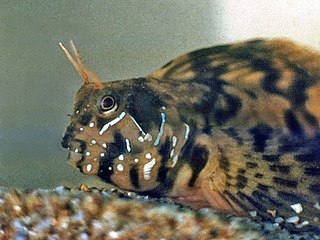
The sphinx blenny is a species of combtooth blenny, and the only species in the genus Aidablennius. It was described by Achille Valenciennes in 1836, originally under the genus Blennius, and was later reassigned under "Aidablennius" by Gilbert Percy Whitley in 1947. It is a subtropical blenny known from Morocco, in the eastern Atlantic Ocean, and also from the Mediterranean and Black Seas. Sphinx blennies inhabit shallow, rocky waters in the littoral zone, with sunlight exposure. They feed primarily on benthic algae, weeds and invertebrates. Sphinx blennies can measure up to 8 centimetres (3.1 in) long in total length.

Alticus is a genus of combtooth blennies found in the Pacific and Indian oceans. It is one of 57 genera in the family Blenniidae.
Alloblennius pictus is a species of combtooth blenny. Lotan originally placed this species in the genus Rhabdoblennius. It is found in the northwestern Indian Ocean. Blennies in this species are oviparous. They can reach a maximum standard length of 2.6 centimetres.
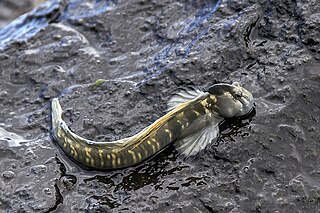
Alticus anjouanae is a species of combtooth blenny in the genus Alticus. Fourmanoir originally placed this species in the genus Andamia. It is a tropical blenny known from Comoros, Seychelles, and Réunion, in the western Indian Ocean. Males can reach a maximum total length of 7.6 centimetres (2.99 inches). Blennies in this species are oviparous and form distinct pairs when mating. They feed primarily off of benthic algae and weeds.

The Pacific leaping blenny, also known as the leaping rockskipper, is a species of combtooth blenny in the genus Alticus. The blennies are oviparous, and form distinct pairs when mating. Males can reach a maximum total length of 8 centimetres. These fish feed primarily on benthic algae, which they consume by scraping off rocky surfaces.

The Kirk's blenny is a species of combtooth blenny in the genus Alticus. It was described by A. Günther in 1964, originally as a member of the genus Salarias. It is a tropical blenny which is known from the Red Sea, Mozambique, Réunion, the Persian Gulf, and India, in the Indian Ocean. Kirk's blennies inhabit waters near the shore, and often spend time out of the water. They are able to breathe air when on land. They are oviparous, and form distinct pairs when mating; they also guard their eggs.

Alticus monochrus is a species of combtooth blenny in the genus Alticus. It is a tropical blenny found in the western Indian Ocean including the Comoros Mozambique, Madagascar, the Seychelles and the Mascarene Islands. It can reach a maximum total length of 10 centimetres. The blennies feed primarily off of benthic algae. They are oviparous.
Alticus simplicirrus, the Marquesan rockstripper, is a species of combtooth blenny found in the central Pacific Ocean, around the Marquesas Islands. This species reaches a length of 3.7 centimetres (1.5 in) SL.
Hoplias patana is a species of trahiras. It is a freshwater fish which is known from Cayenne, French Guiana. The maximum length recorded for this species is 39.4 centimetres.
Hoplias teres is a species of trahiras. It is a tropical, benthopelagic freshwater fish which is known to inhabit Lake Maracaibo in Venezuela. Males can reach a maximum length of 15.3 centimetres.
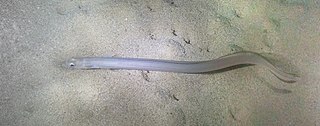
The bandtooth conger, also known as the Baleares conger or the Balearic conger, is an eel in the family Congridae. It was described by François Étienne Delaroche in 1809, originally under the genus Muraena. It is a subtropical, marine eel which is known from the western and eastern Atlantic and the western Indian Ocean, including North Carolina, United States; the northern Gulf of Mexico, northern South America, Canada, Portugal, Angola, the Mediterranean, and the Red Sea. It inhabits reefs and littoral shelves, and burrows into sand and mud. It dwells at a depth range of 1–732 meters (3–2,402 ft), but most frequently between 20–100 m (66–328 ft). Males can reach a maximum total length (TL) of 35 centimetres, but more commonly reach a TL of 25 centimetres (9.8 in)

Gnathophis mystax, the thinlip conger or blacktailed conger, is an eel in the family Congridae. It was described by François Étienne Delaroche in 1809, originally under the genus Muraena. It is a subtropical, marine eel which is known from the eastern Atlantic Ocean, including southern Portugal, the Mediterranean, and Morocco. It dwells at a depth range of 75–800 metres, and inhabits mud and sand on the continental slope. Males can reach a maximum total length of 60 centimetres, but more commonly reach a TL of 35 centimetres.
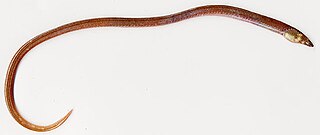
The armless snake eel is an eel in the family Ophichthidae. It was described by François Étienne Delaroche in 1809. It is a subtropical, marine eel which is known from the eastern Atlantic Ocean, including Spain, Mauritania, and the Mediterranean. It dwells at a depth range of 20–80 metres, and forms burrows in mud or sand. Males can reach a maximum total length of 150 centimetres.
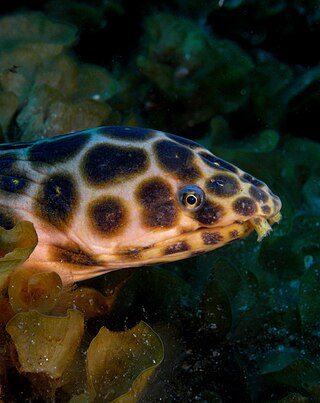
The leopard eel is an eel in the worm or snake eels family, Ophichthidae. It was described by Achille Valenciennes in 1839, originally under the genus Ophisurus.

The fourhorn poacher, also known as the four-horned sea-poacher, is a fish in the family Agonidae. It was described by Achille Valenciennes in 1829, originally under the genus Aspidophorus. It is a marine, temperate water-dwelling fish which is known from the northern Pacific Ocean, including the Sea of Okhotsk, the Sea of Japan, the Bering Sea, the Kuril Islands, and Washington, USA. It is non-migratory, and dwells at a depth range of 0 to 452 metres, most often at around 100 to 150 metres. It inhabits sediments of sand and gravel. Males can reach a maximum total length of 12 centimetres (4.7 in), but more commonly reach a TL of 10 centimetres (3.9 in). The maximum recorded weight is 24 grams (0.053 lb), and the maximum recorded age is 7 years.

The Histoire Naturelle, générale et particulière, avec la description du Cabinet du Roi is an encyclopaedic collection of 36 large (quarto) volumes written between 1749–1804, initially by the Comte de Buffon, and continued in eight more volumes after his death by his colleagues, led by Bernard Germain de Lacépède. The books cover what was known of the "natural sciences" at the time, including what would now be called material science, physics, chemistry and technology as well as the natural history of animals.

Hologymnosus annulatus, the ring wrasse or ringed slender wrasse, is a species of marine ray-finned fish from the family Labridae, the wrasses, which has a wide Indo-Pacific distribution.

















